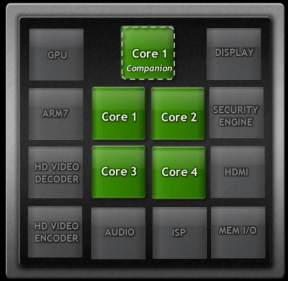There has been a lot of whispering about Nvidia’s next-generation Tegra chip, code-named Kal-El (Superman’s Kryptonian name, for the uninitiated), since it was first detailed on a roadmap back in Februrary. But it hasn’t shown up quite yet in any actual handsets or tablets, though we’re told it has been adopted by the majors and will have its debut soon.
Nvidia today released some new information about the SoC that confirms Tegra’s status as the brand to beat in the mobile computing world. Turns out it’s not quad-core, it’s penta-core. And the “companion core” is designed to take over while all the others go to sleep.
As you have probably suspected, load balancing and optimizing processor use is important to the battery life of many devices. The screen is usually a bigger draw, but with demand for CPU- and GPU-intensive content rising, the portion of a battery used for that processing is as well. But when you’re not playing games or watching HD movies on your phone, those high-power cores don’t operate as efficiently as one designed for low-power, low-priority tasks. So Nvidia put another one on the die, a low-power optimized core, that takes over for mundane things like notification monitoring while the phone is inactive, low-bandwidth stuff like e-reading, and so on.
Nvidia explains it all in this handy diagram, though be on the watch for self-congratulatory jargon (“console-class gaming” isn’t an industry standard term):

It’s a bit like having a city car and a hot rod in your garage. You don’t want to drive your Aston Martin in bumper-to-bumper traffic. That’s why you have a Civic too, or perhaps a Leaf. Same here. Why use ten times the CPU power necessary to perform a simple task?
You can read the rest in Nvidia’s whitepaper (PDF), but take it with a grain of salt, because TI might have some tricks up its sleeve, and even Intel might be creeping up.
